Grown-up friendships Part 2
Here are part two of my notes on Chapter 1. These notes focus on the challenges humans face in creating friendships
Challenges to building friendships
· life transitions, changes: on the one hand, this is the worst time to make friends. On the other hand, this is the time you need them the most. Find people in similar situations like yours. You may be able to learn from them and their experiences.
· Personality- the level at which someone connects with others. For some, this may come easier than most. Here are some hints towards overcoming this difficulty: attend groups that break down into smaller groups (this allows for a more personal interaction), be open, use your friends circle of friends as a starting point (this takes the stress of you to introduce yourself), ask questions to keep the conversation going.
· Sticking to our comfort zone- On page 18, the author analyzes the problem with having un-flexible comfort zones .She says, "The problem with our comfort zones here on earth is that they are narrow, limiting, and growth inhibiting. They prevent us from becoming more like Christ and discovering some of the gifts-such as unexpected friends-that He has for us when we risk being uncomfortable." Be open to new situations. You never know what blessings God might have in store for you
· Busyness
* the Different Seasons of Life*
A season of loneliness sometimes is meant to teach us things. For example, being lonely may teach a reliance on God instead of ourselves.
Don't miss this blowout sale.
Encouragement: A Poem
Well,
I came across this poem with the help of Google alerts. It helps to express the feelings of the disabled community on a daily basis. Written by a group of sisters, it really is meant to make you think and evaluate your actions towards others. After all, you have no idea how you can affect a person. Good or bad.
Think about it.
BEATITUDES TO FRIENDS OF THE PEOPLE WITH DISABILITY
Blessed are you who take time to listen to my difficult speech,
For you help me to know
if I persevere i can be understood,
Blessed are you who never bid me to hurry, or take my tasks for me,
For often I need time rather than help,
Blessed are you who stand beside me as i enter new untried ventures,
For my failures will be out weighed,
by the time I surprise my self to you,
Blessed are you who ask for my help,
For my greatest need is to be needed,
Blessed are you who understand that it is difficult
for me to put my thoughts into words,
Blessed are you, with smile,
Encourage me to try once more,
Blessed are you who never remind me,
That today I ask the same question twice,
Blessed are you who respect me and love me as I am,
Not as you wish I were.
(This poem can be originally located at:
http://schoolforthegirlscourage.blogspot.com/2008/03/friends-to-people-with-disability.html)
The purpose of friendships
Okay,
As promised, here are some of my notes from Chapter 1 of the book. Keep in mind, these are brief and important points in my view. Different points mean different things to different people, so I would suggest buying the book if my observations at all interest you. It certainly has brought to light a lot of things in my friendships.
Anyway, here we go..
Important Notes On Grown-Up Girlfriend
We need friendships because..
- We are created for connectiona.
- Men's Versus Women's Role
- it is different
- Men take care of garden and animals; women are in charge of child rearing and being a companion (Genesis 2: 19- 23, 3: 16
- i. Women crave interactions
- i. The scientific need for friendships
- can lead to longer life
- better odds at surviving medical events
- less chance of developing respiratory problems or cancer
- less chance of developing depression
Prosthetic Gardens

Has Frank Gehry's Millennium Park pavilion somehow uprooted itself and gone nomadic? Did it creep along — like a lumbering, mechanized Ent with chunks of soil, patches of lawn, some award-winning tree cultivars and bewildered dogs and their equally dumbfounded and shrieking owners still clinging to its ribbings — through the few blocks of busy downtown Chicago towards the Sears Tower, where it is now attached, as well as to other skyscrapers nearby, its structural profile reassembled, Transformer-like?

Or are these Chicago's new vertical parks, to where anyone in the buildings, from the chief executives to the accountants in window-less cubicles to the receptionists, can escape the unrelenting woes of the global credit crisis, there contemplating whether to jump or, better yet, change career and enroll in a landscape architecture program?

Are these, then, the solution to a critical shortcoming of green roofs — what of the façades?
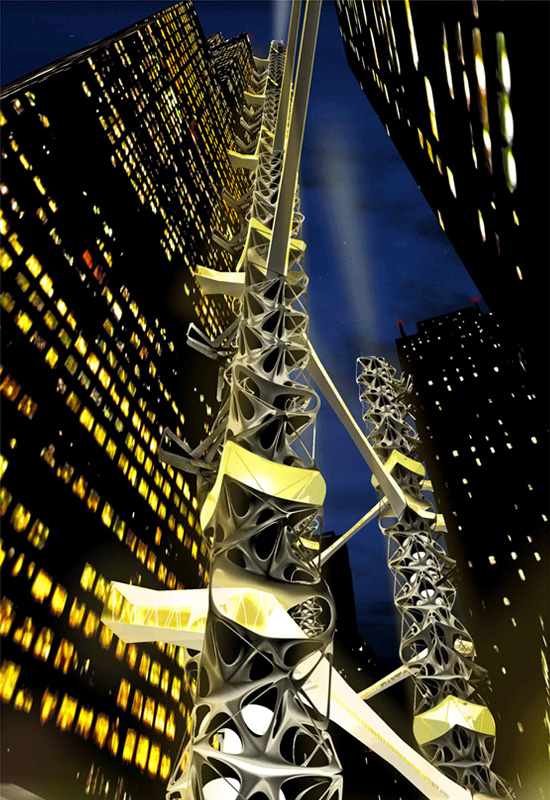
Or was this Daekwon Park's entry for the annual eVolo Skyscraper Competition, a proposal “to reunite the isolated city blocks and insert a multi-layer network of public space, green space and nodes for the city?”
Gut Flora
Bouffant Topiary
Prunings XLI

Blogs, blogs, blogs, except when they're not.
1) Three by “arcady”: gardenhistorygirl, good church design and playscapes.
2) СОВЕТСКАЯ АРХИТЕКТУРА, or Soviet Architecture, as documented by other cosmic communist constructions photographers.
3) Materialecology, by Neri Oxman.
4) At 168 Elm Ave., there is a sustainable pilot project with green stormwater management technologies, best management practices (BMP's) and Low Impact Development (LID) principles.
5) Grist has a special series on the Army Corps of Engineers and the Mississippi River. There are 8 articles.
The New Hydrological Temples of Modern India
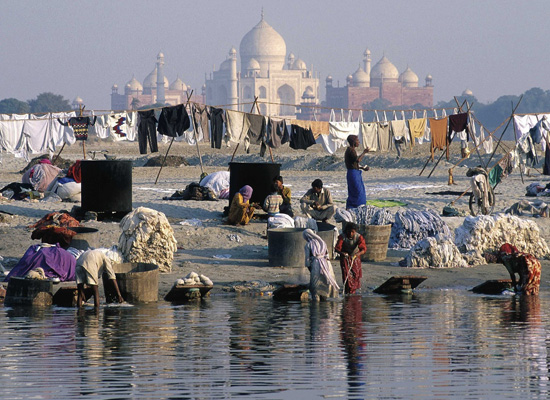
To coincide with tomorrow's World Water Day, the day chosen by the UN “to draw attention to the plight of the more than 1 billion people world wide that lack access to clean, safe drinking water,” Nature has published a special issue on the present and worsening global fresh water shortage.
Our planet is facing a water crisis in public health: more than a billion people in developing nations lack access to safe drinking water, and more than 2 billion lack proper sanitation. And in the near future, water shortages are likely to spread into other key sectors — notably agriculture and energy.
While not merely pointing out the obvious, the issue also takes a look at some of the ways the crisis is being tackled. For instance, you can read about some of the new methods to disinfect and decontaminate water; new efforts to increase water supplies through the safe re-use of wastewater; and new strategies to increase farmers' yield in places where rains are often unreliable.
There is also an article on new technologies to greatly reduce the impact of desalination, called “the most energy-intensive form of water supply,” on the environment.
Every article is available online to non-subscribers but only temporarily, as some of them will be taken behind Nature's pay-per-view firewall in a week's time. So it's a good idea now to download the PDFs and save them in your archives.
Meanwhile, while they are still freely accessible, we'd like to take a closer look at one article about India's gargantuan endeavor “to link the majority of its major river basins through a vast network of canals, diverting billions of litres from the country's more water-rich river basins to those that are water-deprived.”

As if imagined by rogue Army Corps engineers driven out of town after the Katrina fiasco, the project would re-knit the country's hydrological network “through a 10,000-kilometre long network of 30 canals, several of which will intersect with more than one river. The project, which is estimated to cost about US$200 billion, also includes the construction of 32 major dams.”
It's terrestrial reconfiguration as a means to control weather. A recontoured landscapes where the effects of the monsoon cycle are distributed throughout the Subcontinent. A new geography where “dry seasons” and “wet seasons” become less of a temporal experience.
[T]he interlinking project will put an additional 35 million hectares under irrigation — close to doubling the area fed by major irrigation projects in 2003, according to a press statement by Suresh Prabhu, then chairman of the NWDA Taskforce on Interlinking Rivers. In doing so, he stated, the project will combat drought in 250,000 hectares across the country, and reduce flood damage along the Ganges and Brahmaputra rivers basins by some 20–30%. The perennial flooding of these two rivers, which together carry 60% of the nation's freshwater resources, last year caused $850-million worth of damage and killed more than 1,000 people.
Moreover:
[T]he project could also supply about 34,000 megawatts of hydropower — roughly doubling the current level of hydropower, which lies at just over 25% of the country's current electricity needs.
While hard facts are hard to come by, some are nevertheless considering the scheme as the biggest water project in the history of the world, even surpassing China's South-to-North Water Transfer Project.


Of course, as with any new hydrological project of this magnitude, there are calls for less monumental schemes. As but one example of a low impact strategy put forward to solve the water crisis, we read:
The solution lies in better management of existing water resources, rather than importing water for irrigation. A simple way to do this is by using large tanks to collect rainwater, which is later supplied to fields during dry periods. Indian irrigation practices could also be made more efficient. A lot of water is lost in evaporation or through drainage from unsealed irrigation canals, and the common practice of flood irrigation is wasteful compared with drip irrigation, which supplies water directly to the plant's roots. But the water used for irrigation is free, so Indian farmers have little incentive to adopt more economical methods.
But this is India, where “disciplines such as physics and engineering are highly respected” and the environmental sciences are the “untouchables: unseen and unheard.”
As Jawaharlal Nehru, India's first prime minister, once said, dams are the “temple[s] of modern India.”

So one wonders what new deities will spring forth from these concrete rivers and what new rituals will be created to celebrate the wonders of moving water against topography, against gravity.
Will these canals be lined with ghats, like those steps found in the holy city of Varanasi, on which pilgrims descend to “launch religious offerings of sweet-meats, fruit and flowers downstream on a small straw mat” without wading through fecal matter, garbage and strange odors?
Is the spatial ordering of this vast network of canals, as illustrated in the map of India above, really just a 21st century free-form interpretation of the mandala or some other formalized symbol of Indic mythology?
If not, could they be the markings of new pilgrimage routes?
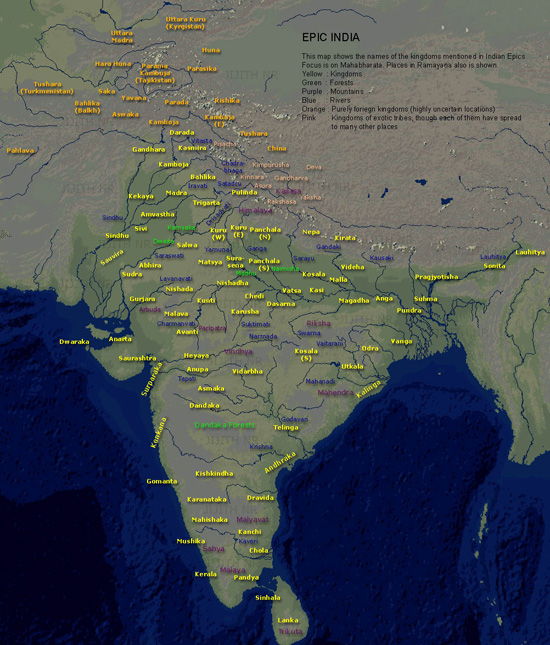
Perhaps when and if the project ever gets finished, a new chapter of the Mahabharata will be written, its epic tales of demons and gods, sages and wise men, civil servants and bureaucrats, hydroengineers and environmentalists largely taking place in these new landscapes.
Dispatches from the Super-Versailles
Floridian Theatrum Machinarum
Notes on Some Selections from the Visual Images Database of the Mississippi Valley Division of the US Army Corps of Engineers
Service
So I'm sure I have talked about this subject of service and faith to God before, but I think it's important to talk about again. The last few weeks have been difficult for me and my family, both on a personal and professional level.
Too often we get caught up in our lives and forget the impact our actions and words have on others.
I have to be honest that was me today. Especially considering my current circumstances and everything going on in my life, it would be so easy for me to say, "I'm not doing this today" or "I'm going back to bed until this day is over ". But I don't. Not only because I know my family and friends (both on earth and in heaven) expect better of me. Or as Judge Hatchett puts it, "I expect great things ."
Well, so does God. He expects and rightly so great things from us. We were created to do great things- not only in our lives or in those of others. In other words, to serve others and satisfy their needs instead of your own. This is not always easy; it requires a keen sense of observation and listening skills in relationships. Sometimes though just living the Christian life is enough, remembering we are supposed to be a positive example to others on a daily basis. This simple concept was brought to my attention through today's devotional.
In that devotional, she tells the story of a day, pretty much like my own, where she struggled to find meaning beyond the confines of her disability.it took the small note of a 11 year old girl to remind her of God's purpose for her life. To serve.
The Bible verse that supports this point of view is: "This service that you perform is not only supplying the needs of God's people but is also overflowing in many expressions of thanks to God. Because of the service by which you have proved yourselves, men will praise God for the obedience that accompanies your confession of the Gospel of Christ, and for your generosity in sharing with them and with everyone else. And in their prayers for you their hearts will go out to you, because of the surpassing grace God has given you. Thanks be to God for his indescribable gift!" --2 Corinthians 9:12-15 from the Message
In closing, Joni always leaves her readers with a short little prayer to God that focuses on today's lesson.
I will leave you with today's prayer:
"Lord, help me to go out today and spend my life for You. Enable me to undertake some special task for You, for this refreshes and enlivens my soul. Help me to exult in distresses of every kind if they but promote service to You and to others."
Resilient Urbanism

According to The New York Times, scientists at Case Western University have created a material that stiffens from a soft state when stimulated. It can also do the reverse, from pliable to rigid. This material, we read, was inspired by the skin of sea cucumbers.
That skin is a nanocomposite material, consisting of tiny fibers of collagen embedded in a softer matrix. When the animal secretes certain chemicals, the fibers form bonds and the whole matrix stiffens.
In their work, described in Science, Dr. Weder and his colleagues used cellulose nanofibers in a polymer matrix. A major difficulty, Dr. Weder said, was having the nanofibers distributed properly, “like a three-dimensional spider web.”
For the time being, experiments on it mainly involve finding new ways to treat Parkinson's disease and other neurological disorders.
Hopefully to no one's surprise, we wonder if they can be used as a building and landscape construction material. An entire city built on sea cucumber-like skins.
Perhaps in next year's City of the Future competition, a brash, up-and-coming design firm will propose encasing San Diego in “stimuli-responsive polymer nanocomposites” so that when the next 10.1 earthquake comes along, the whole city contracts to protect itself.
No, wait — shouldn't that be the other way around? From a hard state to a more elastic state to better ride out the tectonic hurricane? When the tremors end, houses, highways and sewers revert back to their solid state with nary a crack. But if there are any, the sea cucumber polymer matrix will simply patch things up, healing itself, as it were.
Or has someone proposed this already?
In between seismic events, some kind of architectural hacking might ensue.
SpongeCity
Landscape Hints
That book, with the wonderfully wordy title of Sketches and hints on landscape gardening : collected from designs and observations now in the possession of the different noblemen and gentlemen, for whose use they were originally made : the whole tending to establish fixed principles in the art of laying out ground, published in 1794, can be found at the University of Wisconsin Digital Collections.
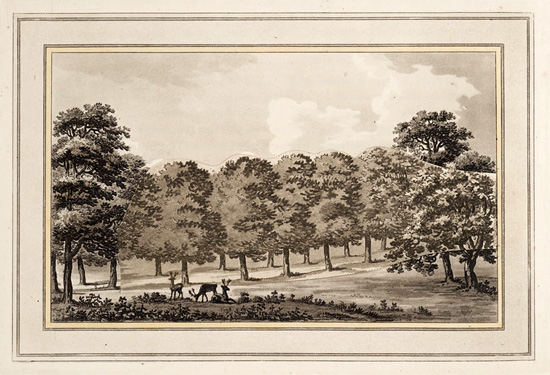

Flip over a flap and a new landscape paradigm just might appear.
Writes gardenhistorygirl — who first alerted us to their online presence:
Long before cable TV popularized instant makeovers of houses, gardens, wardrobes, bodies and souls, Humphrey Repton knew the power of the 'before' and 'after'. His famous Red Books were presentation sketches for his potential clients; lovingly detailed watercolors with flaps that lifted or swept to the side to show in turn the existing landscape and how he proposed to improve it. They are still treasured in museums, national and municipal properties, and private homes across England.
More before-and-after landscapes follow.
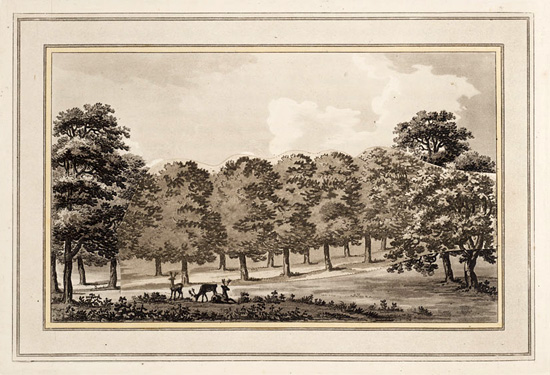


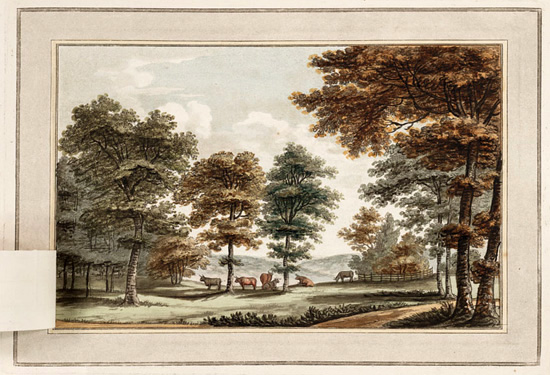




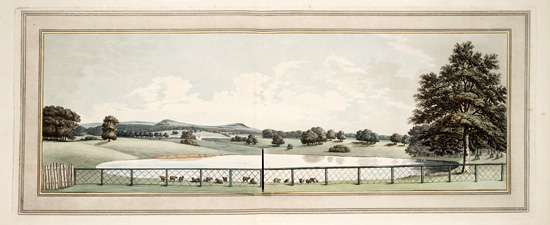

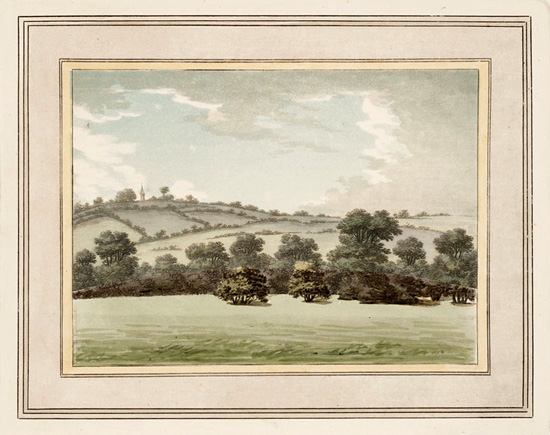

A quick word about these two images, for they are hilarious. The landscape alteration here does not seem to involve any physical changes but rather just the addition of livestock — farm animals as decorative elements, living sculptures even, transforming the English countryside into a mythical Romantic idyll.
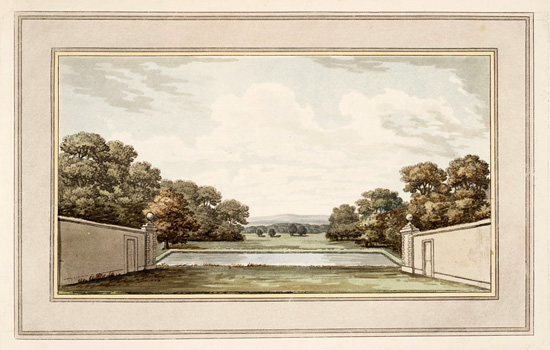

Or you add some sheep.
One wonders if the direct descendant of this pastoral tradition is the current vogue of visualizing landscapes adaptively reused for the coming climate-changed, post-oil, post-water world. And here we're thinking of Farmadelphia, Chicken Wing, Animal Messaging Service, etc. — landscapes which are populated by a new breed of Henry David Thoreaus.
Flip over the digital flap and you find Romantic hero-ecologists practicing an imagined earlier sustainable way of life adopted for an aestheticized vision of the future.
Friendships that matter
I have recently begun reading a book called Grown-up girlfriends by Carrie and Erin. I find the book so intriguing that I have decided to make a series out of it. I wish I could say I would have a scheduled reading and reflection posts. Since I have a busy life, this may be more difficult than I imagine. But I am willing to give it a try.
The first installment is today's post. As a introduction to the series, I will give you a little background on the book and its purpose. The book is written by Erin Smalley and Carrie Oliver- too real grown-up girlfriends. According to Amazon.com, it says: "Even when life is hectic and harried, every woman has a God-given longing for relationship, and her female friends play an important role in filling that. Oliver and Smalley help women distinguish between self-centered, insecure, childish relationships and other-centered, healthy, "grown-up" relationships. Using personal anecdotes and scriptural principles, they explain ten characteristics of a grown-up friend and offer ideas on how readers can develop these attributes in themselves. Finally, they tackle the tough issues of friendships, such as how to support a friend in crisis, how to work toward forgiveness when a friend has injured you, and how to determine when it is best to let a friendship go."
But from what I can tell, the book is this and so much more. These are just some of the topics covered in this book:
1.identify potential soul-mate friends
2. mentor others
3. set healthy boundaries
4.resolve conflicts constructively
5. support a friend in crisis
6. practice healthy forgiveness and reconciliation
7. let go of destructive friendships . . . or avoid them altogether
See you next time when I cover "defining grown-up girlfriends and their purpose".
From now on, any post entitled grown-up girlfriends is part of the series. Feel free to follow along. Who knows if I get enough of a response, I might start a discussion group.
Agro Park
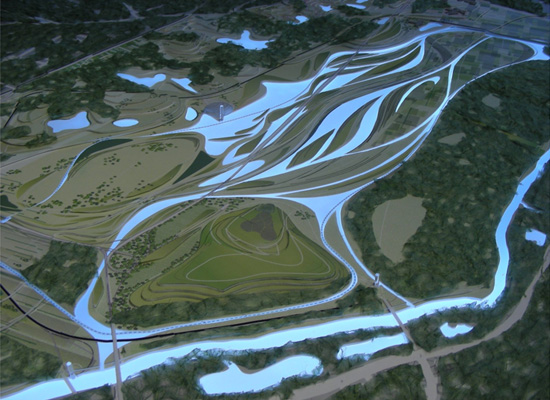
A recent competition asked participants to develop a master plan for Shelby Farms Park in Memphis, Tennessee. The organizers had quite lofty goals. In no uncertain terms, they wanted the newly transformed park be the Central Park of the 21st century. It has to be everything: “a new regional center for growth, a new destination for residents, a jewel of civic pride, and an attraction to people from around the world.” One shouldn't be surprised if at the last minute they decided not to require that it must bring about world peace and end global warming, because why can't we ask of our parks, especially the future great ones, to induce social equality and be like an ecological beast-machine gobbling up all the CO2 produced by the South.
In any case, how does one design a great park? It's a rather dauntingly complex problem, which, as one might suspect, the three chosen finalists peripherally addressed by focusing on another.
How can the agricultural past inform the design of an urban park?
The answers, as provided by Field Operations, Hargreaves Associates and Tom Leader Studio, are very interesting, if not reminiscent.

For Field Operations, agriculture seems to mean hyper-productivity, virility, each day a rigidly structured set of activities. Thus, a hyper-park.
Shelby Farms Park is already today an amazing reserve of public parkland and amenity. It’s huge scale offers an extraordinary resource for people who are interested in large-scale recreation activities – strolling, jogging, cycling, roller-blading, picnicking, dog walking, swimming, camping, horse-back riding, dog training, fishing, shooting, gardening and the like. It’s agricultural heritage is also a great resource for land husbandry practices, including farming, research, energy, education and markets.
Our design vision amplifies these trends toward higher intensity and variety of uses. [...] Twelve distinctive landscapes will each support certain uses and activities, allowing a coherent “place” structure for the many varied user groups set within a larger Park setting.
At 4500 acres, definitely a bigger acreage than Central Park and nearly four times the size of the future Orange County Great Park, there certainly will be enough space to incorporate all of these planned uses.

For Hargreaves Associates, the sweeping monumentality of agricultural landscapes finds expression through their signature style — the braided topography — by which all activities and spaces are organized.

From their project statement:
We have approached the site by examining the site-specific qualities that make it a beloved destination today: expansive fields, sweeping views, spectacular sunsets, rolling hills, nestled lakes, extensive walking trails, equestrian trails and events, farm lands, hands-on learning about agriculture and nature, a country drive, and bottomland forests. There is much at Shelby Farms Park to be discovered.
We have integrated those elements by creating a multi-layered design that intertwines the various existing areas of the park. A network of landscape and movement systems provides for recreation and access by foot, by bike, by horse, by shuttle...and by boat. A system of beautiful lakes that reflect the memorable Memphis sky allows a connection to the river - both real and metaphorical as well as a whole new movement system on the site.
Whereas Field Operations makes use of the grid and compartmentalization, Hargreaves Associates prefers terraforming.

And then there's the master plan by Tom Leader Studio.

Quoting in full:
All you have to do is read the name. The history of farming is the most useful way of thinking when looking toward the future of Shelby Farms Park. This is a huge piece of land that has been in the process of breaking down into 3 or 4 separate domains. Due to the size and available resources, the only viable strategy for creating a singular park is to work closely and dramatically in partnership with nature. That’s what farmers do – they closely study the soil, climate, hydrology, transport, market, and come up with a plan for cultivation that builds on the best aspects of their land. This is a plan for cultivating a very big park. This is how you grow Memphis.
What does that mean? It means we have introduced a whole series of crops that are not literally corn or soybeans but things that address some current issues in the city. For example, health and fitness - how to reverse the trend toward obesity and type 2 diabetes? By developing a substantial local organic farm, restaurant, and sustainable food scene where little currently exists - spawning a whole new green industry. By greatly expanding enjoyable ways to get exercise – swimming, canoeing, trail running, hiking over a vast network. By harvesting enough solar energy to take the park off the grid. By creating a home for the native Memphis music scene – a place where local bands and musicians can gather, find studio space, find a ready-made audience on a big lake with a beach, a place for performance at all scales. These and several other important “crops” for Memphis are what we want to grow here at Shelby Farms Park.
Conceptually, it isn't at all that different from the other two. Minimalism to all three is a non-starter; horror vacui pervades throughout — although, now that we think about it, this is probably a condition of the competition itself, from the organizers being fearful of a perception that public money may seem to have been wasted if there's only nature there and if soccer moms can't occupy their hyperactive broods with things to do at the new park.
In any case, though somewhat more clearly vocalized by Tom Leader Studio, all three finalists have turned the park into a kind of social engineering, a tool with which sedentary, fat, uncultured, carbon-producing Southerners are cultivated into fit environmentalists who may or may not be avid supporters of the local music scene but are otherwise aesthetes.
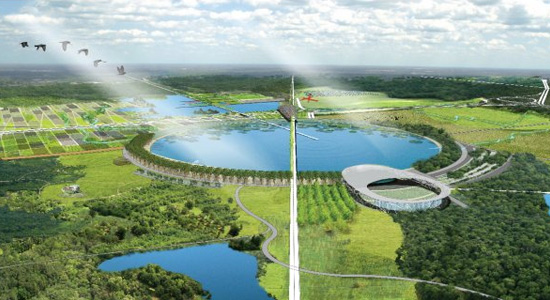
Be sure to check out more images of the master plans by all three teams at the Shelby Farms Park website. Also, the organizers have set up a YouTube account where you can watch videos about the park itself, the competition and interviews with the principal designers.
The winning design will be announced on April 9, 2008.
POSTSCRIPT #1: Field Operations wins!
On agro
Starting young
It's been a difficult week, full of personal struggles and family difficulties. But I couldn't let that keep me from posting. Personally, I don't know what to say after everything I have been through, so I am going straight to my post topic.
Growing up, a lot of people don't know how to deal with people with disabilities . They don't know what to do or how it act around the disabled community. I think a lot of this comes from the way that people have grown up and the way they have been taught .
I came across this blog which highlights a book for young children talking about being paralyzed. This story deals head on with the stereotypes they may have. Some of these include thinking that we are helpless and can't do anything by ourselves.
Check it out
http://cedir.blogspot.com/2008/03/aunt-katies-visit.html
More Defiant Gardens
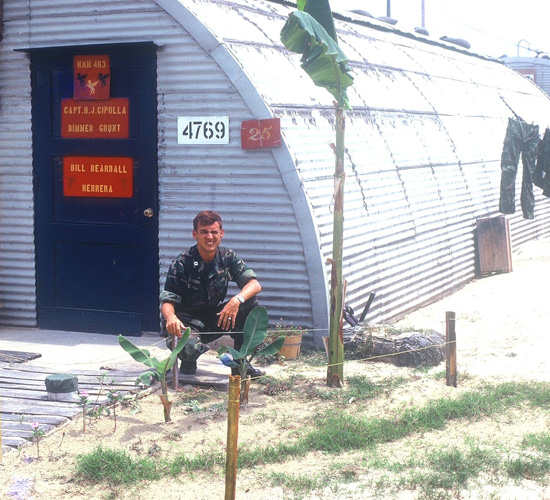
In the midst of wars, there are gardens. Here are photographs of three and their gardeners; all were downloaded from
Above is a photo Bill Beardall during his tour of duty in Vietnam in 1970. In a letter to Kenneth Helphand, author of Defiant Gardens (the book), Beardall wrote about his “oasis”:
It had a calming affect on me to come back to my ‘hootch’ where, as a Marine Helicopter Pilot, after a long day of flying missions in the I Corps area to see a little bit of green growing by my doorway. What you see in the first attachment is early in my garden’s life. The bananas grew much taller, the periwinkles as well. The watermelon actually produced fruit, although by the time they were beginning to show any size, the Marines pulled out of Vietnam.
And:
Persistent watering kept [the bananas] flourishing, much to the amusement of my squadron mates and the Vietnamese workers in our area. The Portulaca [and] periwinkle [...] were for color, easy to grow, and satisfied my artistic need for a change from the olive drab of our flight suits and aircraft. The watermelon was simply a challenge and a wish for the wet lushness of the fruit. As small as it was, it was my oasis. Many a day or late evening I would sit on my ‘patio’ drink a ‘cocktail’ and enjoy the setting of the sun in the West. I could almost block out the medevac choppers going out and the sound of the artillery in the distance. I have never forgotten much from that war and never my oasis.
Several decades later, in another conflict region, one still finds evidence of this primordial desire to cultivate.
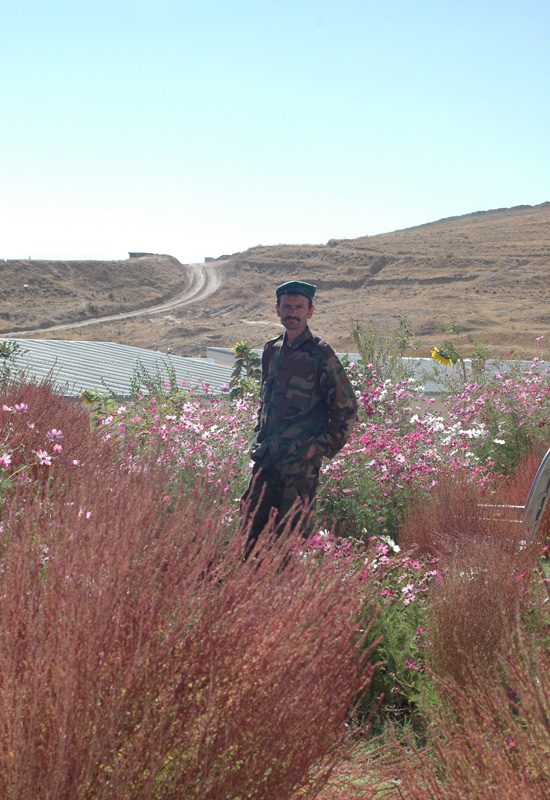
From Kabul, Lt. Janette Arencibia wrote to Helphand:
I have been here for three weeks and have a year to go. Other soldiers (including coalition forces) have been establishing gardens in this country for the last several years.
My job as a gardener is to share my passion with the other wonderful individuals who have already made Afghanistan more beautiful.
I am attaching a few pictures from a small garden in Kabul, specifically at Camp Cobra, an Afghan National Army base. This garden was created by an officer in the Afghan National Army with a passion for flowers. I listened to him passionately tell the story of the origin of the seeds.
One country over towards the east, another garden is passionately tended to.
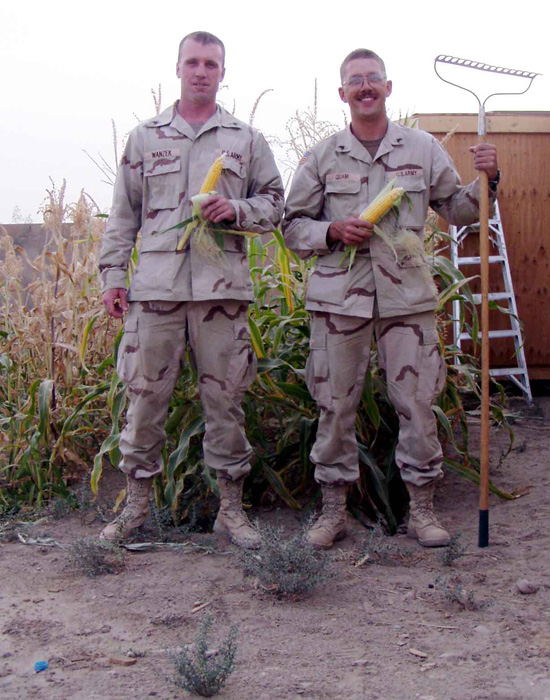
From Sgt. Carl J Quam, Jr.:
I came up with the idea, along with Sgt Wanzek, because we were missing home, farming, and the joy of growing something. We had a spell when supply lines were all but cut by the insurgents, and I said we might be able to grow our own vegetables, since the MREs dont have them and the supply trucks werent making it to our FOB. Friends of myself and SGT Wanzek, named Nathan and Stacy Hoehn in Valley City, ND, had the seeds donated by the Valley City Nursery. The Hoehns also sent over some garden hose and a sprinkler, the sprinker we didn’t use. We learned from the locals to irrigate with deep trenches and let the water soak into the dirt in between. [...] At the time of garden prep, planting, weeding and watering, Sgt Wanzek and myself, along with the rest of our crew, were running 4-6 combat patrols a week, in 100-140 degree weather. When we came back to our area, we had a hard time getting motivated to work and weed, but we did. Like I said, it was good therapy to relax after a day of dodging roadside bombs, RPGs and escorting semi trucks full of unexploded ordinance over the worst stretch of road in northern Iraq.
We wanted to include the gardens tended to by detainees at Camp Iguana in Guantanamo Bay — yes, even those in limbo have gardens; with seeds saved from their meals, they were able to grow small plants like watermelon, peppers, garlic, cantaloupe and even a lemon tree about two inches tall — but unfortunately, there are no photos to be found. Perhaps you have some and are willing to share?
Defiant Gardens
Prunings XL
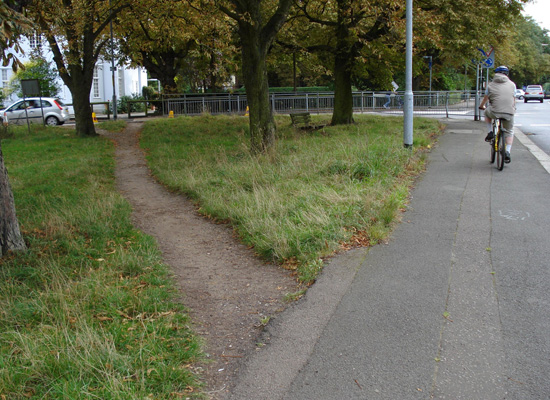
Landscapes, landscapes, landscapes...
Let's start with io9 on “show caves,” the garden grottoes of the 21st century.
In an earlier age, these simulated abysses were the playgrounds of kings and their terminally bored queen consorts; popes and their cardinals, who may or may not have been their illegitimate sons; and the titled nobility and the desperate lesser aristocrats. Now, as suggested by Geoff Manaugh, these Hadeses in miniature should be taken up by “investor class Brits, hip-hop moguls, and easy-money Hollywood types.” Instead of getting drunk every night or coming up with another act to fool doctors into prescribing them drugs, they funnel their money and creative energies into “vast, echoless complex[es]” whose “stalactites have been precision-cut by CNC-milling machines, the walls shaped by computer-programmable routers.”
Especially for those whose summer blockbusters hits have never really given them much satisfaction, they might find the artistic fulfillment they have long sought in these void canvases.
But as an aside, it is said that Marie Antoinette tried to escape from the mob that had come to take her to Paris, and eventually to prison, in the grotto of the Petit Trianon. Intended as a site for diversions, a refuge from the rigid protocols of the royal court, the grotto was also one of the stops on her way to the guillotine.
A contemporary re-imagining of this anecdote might involve a young, successful independent film actor; an addiction to show caves that spirals out of control, causing him to loose his grip on reality; a mob of TMZ paparazzi; and some prescription drugs. Jules Verne: A True Hollywood Story.
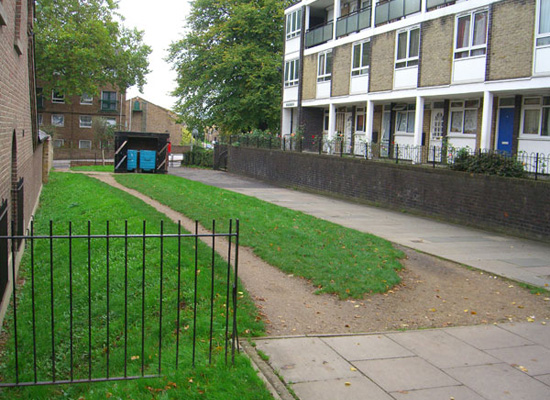
Next we have Wikipedia on KBR, Inc., the engineering and construction company, formerly a subsidiary of Halliburton. Some of the company's projects undertaken for the U.S. government include Camp Bondsteel in Kosovo. “The camp,” we read, “is built mainly of wooden, semi permanent SEA (South East Asia) huts and is surrounded by a 2.5 meter high earthen wall. To construct the base two hills were lopped off and the valley between them was filled with the resulting material.”
In Afghanistan, “KBR was awarded a $100 million contract in 2002 to build a new U.S. embassy in Kabul.” The company also receive $216 million “for work under Operation Enduring Freedom” which involved “establishing base camps at Kandahar and Bagram Air Base and training foreign troops from the Republic of Georgia.”
KBR's activities in Iraq are no less extensive. “The United States Army hired KBR to provide housing for approximately 100,000 soldiers in Iraq in a contract worth $200 million, based on a long-term contract signed in December 2001 under the Logistics Civil Augmentation Program (LOGCAP). Other LOGCAP orders have included a pre-invasion order to repair oil facilities in Iraq” and “$28.2 million to build POW camps.”
We now wait for the Princeton Architectural Press or Actar or, dare we dream, Spacemaker Press to publish a much needed critical appraisal of KBR, Inc. and its adventures in military urbanism.
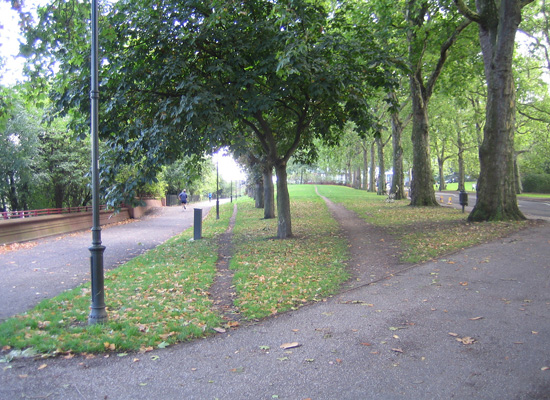
Now on to Vapor, a new exhibition at the Southern Exposure gallery in San Francisco in which Amy Balkin, Futurefarmers, Natalie Jeremijenko, The Living, Eric Paulos and Preemptive Media takes on “our declining air quality as the subject matter, medium and metaphor for creative work.”
Often inspired by forms of activism, the works react to the sources of climate change through the use of technologies – sensors, databases, and communications equipment – that are only recently accessible outside a lab. In this sense, the show's title also refers to the growing means by which this art is being produced, in addition to the ubiquity of greenhouse gases and other air conditions that serve as this art’s medium. Vapor proposes new ways of modeling, testing and finding solutions to the problems of air quality and greenhouse gas emissions.
Via Loud Paper.
One wonders what Correggio might have created with air quality as his subject matter and medium. Perhaps a new version of his Jupiter and Io inspired by the recent reports of dust storms blowing from the Gobi Desert and across over the Yellow Sea. Jupiter rendered as vaporized earth, dyed with the toxins of an industrialized China, on its way to its yearly tryst with Io, i.e., a timid Korea and an emasculated Japan. Erotic rapture turns into bloodied respiratory convulsions.
Or what about John Constable and J.W. Turner? How would those cloud-obsessed painters have approached smog?
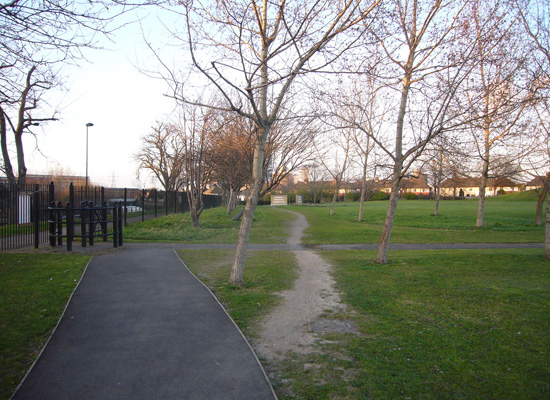
Moving on to dams, reservoirs and their effect on sea level change.
Reporting on a research led by Benjamin Chao of the National Central University in Taiwan, National Geographic News tells us that “dams and reservoirs have stored so much water over the past several decades that they have masked surging sea levels.” In fact, “without dams, sea levels would have risen 30 percent more than they already have.”
So while the world waits for green technologies and sustainability practices to deliver on their promises and for China and India to adopt them, and then afterwards wait yet again for the expected results to show up, we should have the Israelis to put up barrier walls around Antarctica and Greenland to contain all their fresh water so that Bangladesh don't have to suffer climatic genocide.
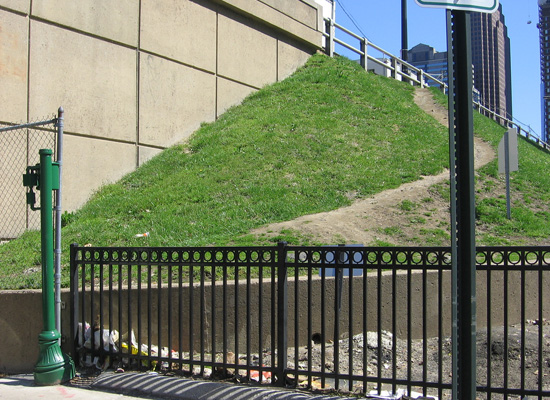
Onwards to slum tourism, or “poorism.” From The New York Times:
From the favelas of Rio de Janeiro to the townships of Johannesburg to the garbage dumps of Mexico, tourists are forsaking, at least for a while, beaches and museums for crowded, dirty — and in many ways surprising — slums.
Is this voyeurism? Is it exploitation? Does it “change the reputation of the slums one tourist at a time?” Sponsor our trip, and we'll report back to you.
Meanwhile, one tourist was quoted in the article as saying something extraordinarily interesting. Speaking of an incident during her tour to one of Rio de Janeiro's favelas, specifically when “a young man approached the group, smiling and holding a cocked gun,” Rajika Bhasin said she became “just very aware of [her] surroundings, and aware of the fact that [she] was on this guy’s turf.”
Can one, then, become better attuned to the intricacies of the built environment when placed under threat of bodily harm? Can landscape architecture students acquire a more robust set of landscape reading skills if they are dropped down every academic year in the middle of Rocinha or Soweto and left there to fend for themselves for a week?
Flânerie in the slums.
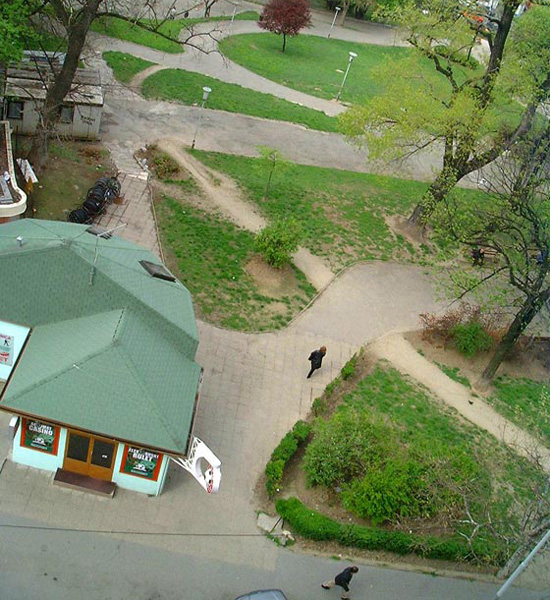
And finally, on the impending coastal crisis, a good overview of landscapes at risk.
By mid-century, more than half of the U.S. population will live within a day’s drive of a coast or lakeshore. Once the realm of small villages and ocean-based economies, these areas are now heavily developed and populated with tourists and secondary homes. Many inhabitants appreciate the scenery, but assume shorelines never change.
That's because they're idiots!
Billions of years of geologic history have shown that coastal areas are the least constant features on the planet’s surface. Tropical storms (hurricanes) and extratropical storms (Pacific storms, nor’easters) devastate shorelines. In addition, the post-glacial rise in sea level enables storm surges to destroy coastal areas at higher and higher elevations each century. Fixed structures built on coasts with rising sea levels may be doomed.
And we'll report here when they fail.
Positive images on disability
So,
I was looking through my e-mails and thanks to my Google alerts came across these positive images of disability. The ads are part of a campaign to sell cars, although some people may see this as a marketing strategy and may be offended, I don't. I see this as a way of breaking down stereotypes that people may have about the disabled community.
Now, I can understand how some people can be offended relating our ability to persevere to that of a car. But it all depends on how you see the picture.
How do you see this campaign? Check out another person's viewpoint at:http://similinton.com/blog/?p=109
News Flash: Governor likes strawberries!!!
(from PR-net)
California Governor Arnold Schwarzenegger and Ben Weider met at the Arnold Schwarzenegger Bodybuilding Classic in Columbus, OH, where the Governor held up a copy of Weider's newly published book, The Wars Against Napoleon: Debunking the Myth of the Napoleonic Wars, by authors General Michel Franceschi and Ben Weider and published by Savas Beatie LLC.
Governor Schwarzenegger organizes yearly the Arnold Schwarzenegger Bodybuilding Classic (http://www.arnoldclassic.com/). Every year he selects an outstanding individual and honors him for his contribution to health, fitness, and bodybuilding.
This year, Governor Schwarzenegger selected Ben Weider, who is the Founder and Honorary Lifetime President of the International Federation of Bodybuilding & Fitness (http://www.ifbb.com/). Ben Weider is also the president of The International Napoleonic Society (http://www.societenapoleonienne.com/english/frameSetAccueil_Eng.htm).
Governor Schwarzenegger presented Weider with The Lifetime Achievement Award in front of 5,000 cheering fans. When asked about his opinion of Governor Schwarzenegger, Ben Weider replied, "Arnold Schwarzenegger is indeed one of the most intelligent people I have ever met. His perseverance, charming personality, and ability to solve problems and achieve results are what make him an outstanding individual."
Governor Schwarzenegger is also interested in history and was pleased when Ben Weider, a Napoleonic historian, signed a copy of his new book entitled The Wars Against Napoleon: Debunking the Myth of the Napoleonic Wars (http://savasbeatie.com/books/Napoleon_book.htm).
"I have read The Wars Against Napoleon, and I liked it," announced Governor Schwarzenegger.
Popular and scholarly history presents a one-dimensional image of Napoleon as an inveterate instigator of war who repeatedly sought large scale military conquests. General Franceschi and Weider dismantle this false conclusion in The Wars Against Napoleon. Publishers Weekly called the book "Provocative . . . revisionist . . . and controversial." According to Library Journal, "The authors argue strongly, persuasively, and intellectually for what is, essentially, the other side of the usual story. They will surely provoke debate within the historical community wherever there is interest in this period. Recommended for all libraries adding to their Napoleonic collections."
Weider explains that his and Franceschi's long persuasive essay turns our understanding of the French emperor on its head. "Napoleon's desire to spread 'liberty, fraternity and equality' to all citizens of France, and then to all citizens of countries that were occupied by the French Army, is what gained my respect and interest in Napoleon and the period in which he lived," explained Weider.
NOTE: IF USED, GOVERNOR ARNOLD SCHWARZENEGGER'S QUOTATION CANNOT BE ALTERED OR EDITED IN ANY MANNER.
NOTE: I did not alter this in any manner. The press release was reproduced as written.
NFL Star sues supplement company
(From Brent Schrotenboer of the San Diego Union-Tribune)
Athletes who fail drug tests these days often give the same excuse:
“It wasn't my fault. I didn't know my vitamins were tainted with steroids.”
To skeptics, it sounds like a schoolboy claiming that his dog ate his homework.
But recently many athletes have been taking their arguments to court to prove they mean it – often with successful results.
The latest attempt came Friday in San Diego Superior Court, where former San Diego State and NFL running back Femi Ayanbadejo filed suit against a Nevada supplement company and local distributor. Ayanbadejo tested positive for a steroidal substance last year, leading to a four-game suspension and his release by the Arizona Cardinals and Chicago Bears.
“I took a supplement that had a banned substance in it that was not listed on the bottle,” Ayanbadejo said yesterday. “I know a lot of guys have been using that excuse. But I said from the beginning that I was going to sue the company and make sure that whoever was responsible would face the music.”
If his claims are true then I hope he wins the suit and the company in question is fined severely. The fight to keep supplements legal is going to involve holding company's feet to the fire regarding accurate label claims.
Aurora Bibliothèque

“For reasons not fully understood by scientists,” NASA tells us, “the weeks around the vernal equinox are prone to Northern Lights.”
This is a bit of a puzzle. Auroras are caused by solar activity, but the sun doesn’t know what season it is on Earth. So how could one season yield more auroras than another?
To better understand auroras, NASA sent five satellites, collectively called THEMIS, or Time History of Events and Macroscale Interactions during Substorms. During the mission's first year of operations, the satellites have “observed one geomagnetic storm with a total energy of five hundred thousand billion (5 x 10^14) Joules,” which is “approximately equivalent to the energy of a magnitude 5.5 earthquake.” And then there are those so-called magnetic ropes, which are magnetic fields that are “organized much like the twisted hemp of a mariner’s rope connecting Earth's upper atmosphere directly to the sun. Solar wind particles flow along the ropes in whirligig trajectories leading from the sun to Earth.”
To repeat: Solar wind particles flow along the ropes in whirligig trajectories leading from the sun to Earth.

Having recently been alerted by BLDGBLOG to these proposals for the George W. Bush Presidential Library — speculative architecture via air mail; manifestos for $0.41 — we can't help but wonder:
Can you build a library out of auroras?
Can these shimmering ribbons of earthly solarity be turned into a repository of knowledge?
Using a translation matrix yet to be programmed and actuators yet to be invented, you could digitize, say, the entire content of BLDGBLOG into charged electrons and protons, which you would thereafter eject from a fleet of satellites orbiting between the earth and the sun. These particles would then hitch a ride on solar winds, eventually colliding with artificially produced charged particles floating in a finely reconfigured magnetosphere. Writing in the sky with remnants of stars.
Or you could use the satellites to weave and unravel those “magnetic ropes” to manipulate the flow of solar wind particles, as one would strum the strings of a cello to create certain photonic vibrations.
Alternatively, instead of satellites, you could have a gigantic circular struts floating above the poles. Through millions of spray nozzles, charged particles will be exhaled, the amount and timing and direction being determined by a complex algorithm yet to be conceived.

When all things are working (or not working), the polar regions will be alight with the transliterated works of Mr. Manaugh. The whole landscapes singing Homeric tales of undiscovered subterranean rooms, lunar urbanism, buttressed buttresses and magmatic Baroque churches. The still waters of the Icelandic fjords and the hushed glacial fields of Alaska filled with the geomagnetic crackling of encoded artificial islands and algal farms.
However, in order to listen to them — i.e., to read them — patrons would need to use sensors yet to be developed located in spaces yet to be spatialized.
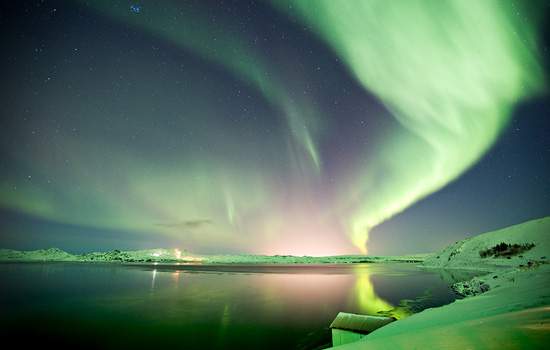
A couple of things:
1) Going back to the original question, should that now ask: can you make auroras out of libraries?
2) Not in a million years did we think that we would ever reference Babylon 5 and Diller+Scofidio in a single sentence in this landscape architecture blog, but our description above reminded us of the Shadow Planet Killer and the Blur Building.

Could Dani Karavan's Negev Desert observatory serve as a model for the library's access terminals?

“But shouldn't libraries be universally accessible?” you might object. “Not everyone can afford the trip. A few can't even stand the cold.”
Very well then. Forget BLDGBLOG — sorry, G! — this will be the new wing of the Vatican Secret Archives, open only to scholars with academic credentials and well-funded fellowships. In fact, forget our north pole, let's make them even more inaccessible and file them on other planets.
Heretical gospels howling by Jupiter's magnetic fields.

For more photos of auroras, check out this Flickr pool.
Goodbye, Alaska!
Vapour City
